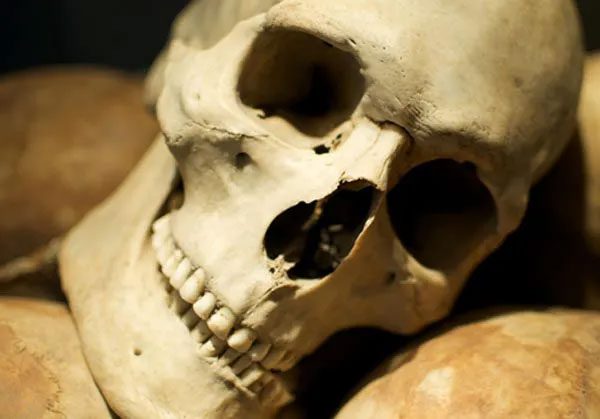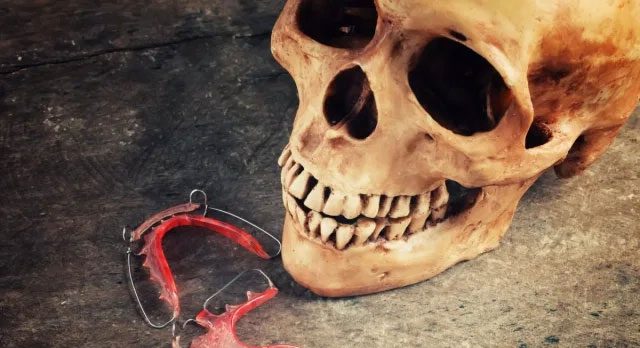Today, experts estimate that about 25% to 50% of people require orthodontic intervention. In contrast, fossils reveal that ancient humans often had straight teeth and normal wisdom tooth growth.
According to fossil records, ancient humans typically had perfectly aligned teeth and wisdom teeth that grew normally. In fact, the need for braces and wisdom tooth extraction has only developed in recent times. So, what has happened?
While it is almost impossible to pinpoint the exact cause, scientists have proposed a hypothesis.
Specifically, millions of years ago, the ancestors of modern humans lived a subsistence lifestyle. Therefore, their teeth and jaws had to work hard to digest food. Indeed, the surfaces of ancient human teeth show extensive wear and flattening. Moreover, they also had larger jaws and teeth compared to modern humans. When the ancestors of modern humans began using tools and fire to cook and prepare food, their jaws became more efficient at grinding and tearing food.

Ancient humans often had straight teeth and normal wisdom tooth growth. (Photo: Ancientorigins).
Many years later, around 12,000 years ago, humans began to engage in agriculture and animal husbandry. Over thousands of years, they became increasingly familiar with processing and refining food.
In particular, milling technology helped remove tougher parts of grains, such as the husk and bran from rice and wheat. Then, with the advent of the Industrial Revolution, technological advancements significantly accelerated these processes. In a relatively short time, human mouths were freed from the heavy tasks of grinding food. Interestingly, it was also during this period that misaligned teeth seemed to become more common.
Is this the reason why human teeth are misaligned?

Ancestors of humans had larger jaws, so their wisdom teeth did not become misaligned or impacted. (Photo: Shutterstock)
By studying human fossils over millions of years of evolution, scientists have observed that the size of teeth and jaws in humans and their ancestors has gradually decreased over time.
Many believe that throughout much of human history, dietary changes, such as the introduction of meat and cooking, led to changes in the size of teeth and jaws that essentially kept pace with each other.
However, with significant recent changes in agricultural and culinary practices, that relationship has shifted. Theoretically, in a relatively short time, the jaw size of some human populations has decreased while tooth size has remained the same. This also means that human teeth have to struggle for space. Specifically, as teeth emerge, they may crowd each other, even being pushed into misaligned positions.
Subsequently, wisdom teeth, the last teeth to appear, seem to complicate matters further. In many cases, wisdom teeth have little or no space to grow. This leads to impacted wisdom teeth, causing discomfort and potential infections if they are not extracted.

Many modern individuals require orthodontic intervention for a beautiful smile. (Illustrative image).
Larger teeth seem to be related to a greater need for chewing. Therefore, many scientists suggest that as human diets require less chewing, their jaws have also become smaller. This has led to overcrowded teeth, causing misalignment and impacted wisdom teeth.
In fact, some preliminary experiments support this hypothesis. In a study conducted in 1983, researchers fed 42 squirrel monkeys two diets: one with natural hard foods and the other with artificial soft foods. The results showed that the monkeys fed soft foods had more crowded teeth, and some teeth were even displaced from their positions, resulting in narrower dental arches.
Additionally, a study in 2004 observed similar findings when Hyraxes (also known as rock rabbits) were fed cooked foods. They had facial regions related to chewing that developed about 10% less than those of rabbits that ate raw and dry foods.
In conclusion, the issue of misaligned teeth seems primarily due to environmental or lifestyle factors rather than genetics, although genetic factors may play a role in some cases. Experts estimate that around 30% to 60% of modern individuals experience some degree of misalignment. However, this trend varies among human populations globally. In fact, some people never develop wisdom teeth. Others do not experience overcrowding or misalignment, and their wisdom teeth emerge without issues.





















































